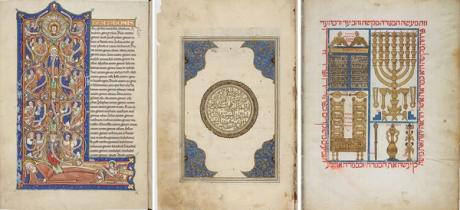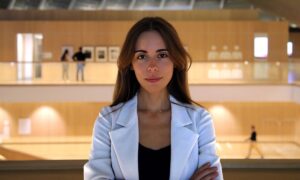
As well as having a common founding figure in Abraham, the three monotheist religions of Judaism, Christianity and Islam all share a deep veneration of the written word. The Torah, the Bible and the Quran are not only religious texts but are among the greatest achievements of poetry and literature and have for millennia inspired the finest works of art, calligraphy and craftsmanship.The exhibition Letters of Light at Louvre Abu Dhabi brings together some of the oldest and most important manuscripts from the three faiths, shining a light not just on their aesthetic beauty, but also the shared traditions and histories.“This is the first time that so many holy books and precious illuminated manuscripts will be gathered and exhibited in this region of the world,” says one of the show’s curators, Laurent Héricher, head of the Oriental manuscripts department at the Bibliothèque nationale de France. “This is a concentration of sacredness, of holiness.”A folio from the Blue Quran, from the collection of the Louvre Abu Dhabi (late 8th-10th century) © Department of Culture and Tourism—Abu Dhabi / Photo APFThe exhibits range from the ancient to the space-age. Some of the most exciting loans in the show are fragments of the 1st century Dead Sea Scrolls—the earliest known manuscripts of the Hebrew bible. You can also see the richly illuminated Souvigny Bible from 12th century France and an ingenious 18th century Islamic prayer book with hexagonal pages that fold out like a flower.More recent is the world’s smallest bible to have travelled across space: the Nano Bible, which was taken to the International Space Station last year. The size of a grain of sugar, it contains 1.2 million letters inscribed with nanotechnology.A highlight from Louvre Abu Dhabi’s own collection is a folio from the Blue Quran. One of the most ancient copies of the Quran to survive the present day, it dates from the 9th or 10th century. The deep blue background symbolises the universe; the glittering gold letters the divine light spread by the word of God. The writing is an early Arabic script type: angular, very geometric and surprisingly modern.Artworks on show include Giovanni Bellini’s Virgin and Child (1480-85) from the Louvre Abu Dhabi’s collection © Department of Culture and Tourism—Abu Dhabi / Photo Thierry OllivierThe exhibition’s other curator is Souraya Noujaim, the director of the Islamic Arts department at the Louvre in Paris. “The exhibition in a way tells the story of the birth of writing,” she says. “It tells the story of languages and the evolution of forms from the scroll to the codex. It talks about translations, it talks about printing.” It shows the influence of the holy writings on the intellectual life of Europe, including the first Gutenberg bible to be shown in the Middle East.About 80% of the more than 240 objects on display are manuscripts: they are supplemented by artworks including engravings by Rembrandt van Rijn, drawings by Marc Chagall and a painting of the Virgin and Child (circa 1480-50) by Giovanni Bellini. The exhibition is closed by meditative artwork by Muhannad Shono, titled The Unseen. Threads of light evoke a black hole, “a metaphorical representation of the mysterious and incomprehensible aspects of existence”.The exhibition concludes with Muhannad Shono’s The Unseen (2023). © Department of Culture and Tourism – Abu Dhabi / Photo by Siddharth SivaIn a previous exhibition at the Bibliothèque nationale de France, the three religions were dealt with separately. At Louvre Abu Dhabi, in accord with the museum’s goal of showing the interconnections between cultures, they are shown together.“So we see that those traditions have a lot in common,” says Héricher. “It’s like being at home: you know your neighbours, but you’ve never really talked to them. But once they invite you for coffee and tea and then you start asking questions about their lives, about their traditions, about their culture [you find what connects you].”The director of Louvre Abu Dhabi, Manuel Rabaté, sums it up: “This exhibition not only reflects the United Arab Emirates’ commitment to open-mindedness, tolerance and respect, but also reinforces our unwavering dedication to fostering open hearts, open eyes, and open minds, forging connections that transcend time, place and geography.”Letters of Light, Louvre Abu Dhabi, 13 September-14 January 2024


























